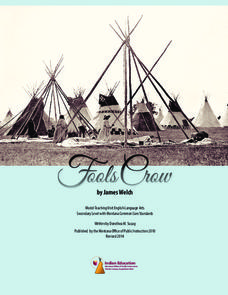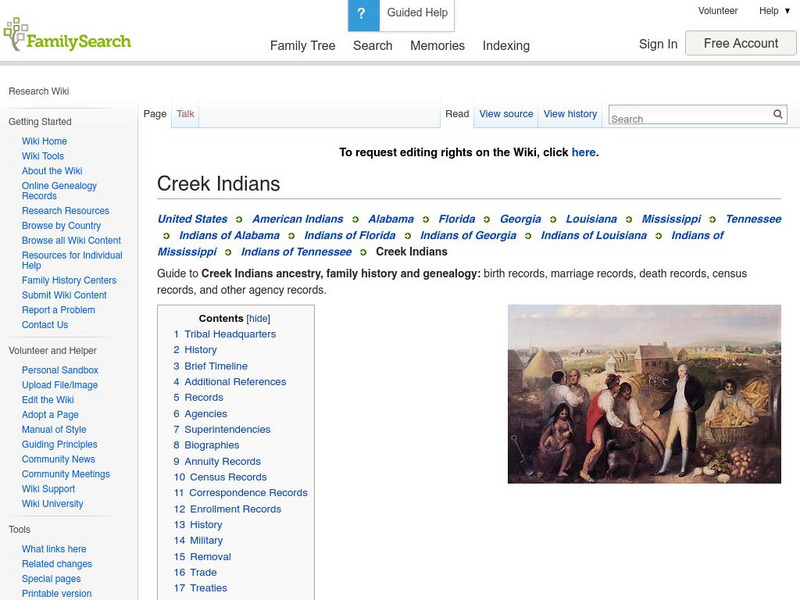K20 LEARN
Reconstruction Treaties Of 1866: The Reconstruction In Indian Territory
The Reconstruction Treaties of 1866 and their impact on the Five Tribes in the United States Civil War are the focus of a lesson that asks young historians to consider how these treaties affected tribal sovereignty. Class members do a...
Curated OER
Mystery State #16
In this mystery state worksheet, students answer five clues in an attempt to identify the state in question. Then, students locate it on a map.
Curated OER
James Welch's Fools Crow
Learners explore the history of Montana's Native Americans by reading James Welch's Fools Crow. Set shortly after the Civil War, the novel focuses on a young Blackfoot Indian and his tribe. Over the course of several weeks, class members...
Curated OER
Romans of the New World
Who were the Iroquois, and how did they compare with the Romans? Attached is a three-page article and a set of accompanying questions. Only four questions are included, but you could require your readers to write two or three...
Curated OER
First Meeting of the Indians and the Europeans
Your class hears a Native American Indian point of view of Europeans' arrival in Louisiana. They assess how cultural perspectives (especially an insider's view) and native language can shape a story. Each pupil identifies the...
Curated OER
Ceremony
Students complete multiple lessons to identify the human rights and social justice for Native Americans. In this human rights lesson, students complete fifty one days of activities to a lesson titled "Ceremony" about the Native...
Stanford University
Great Plains Homesteaders
"Westward, ho!" may have been their cry in spite of the hardships. Using a series of photographs by Solomon D. Butcher of those who ventured west, class members consider what life was like in the 1800s for those who embarked on the...
Curated OER
Cadron Settlement and the Trail of Tears
Middle schoolers examine the reason for removal of the Cherokee and other Indian nations. They map the water route of the Trail of Tears from its origination in the east and through the Arkansas River Valley to Indian Territory.
Curated OER
Learning about Native Americans through Artifact Analysis and Artwork
Sixth graders assess how a Native American's environment and the geographic region where they lived influenced their food, clothing, shelter and the overall culture of a tribe. They study the impact of conservation, family, rural life,...
Curated OER
American Indians
Students research early Indian adaptations in this lesson. They research the different American Indian tribes. They also research and compare the tribes' rituals, daily lives, and their impact on the Europeans who came later to the...
Curated OER
Red Dirt Groundbreakers
Discover Oklahoma's first farmers. Read about 14 different agriculture workers and their contribution to Oklahoma's farming. After reading, have your class complete several activities such as researching an agriculturist, writing a...
Curated OER
Baroque Composers
Fourth graders study Baroque composers. In this music lesson, rotate trough three stations, collecting information on particular Baroque composers. Worksheets, information cards, and procedure included.
Curated OER
The Cherokee: Trail Where They Cried
Learners read the Trail of Tears about the Cherokee Nation removal and write a letter pretending they are the grandparent of a Cherokee child. In this Trail of Tears lesson plan, students understand the changing of boundaries.
Curated OER
American Indian Tribal Sovereignty
Seventh graders examine the relationship among the governments of the sovereign American Indian Nations in Utah, the State of Utah, and the U.S. They list the objectives of the Office of Indian Affairs and examine their purpose.
Curated OER
Tapokadooa: How the Dawes Act Affected Northern Paiute Children's Lives
Learners investigate the Dawes Act and understand its effects on the Paiute Indians. In this Paiute lesson, students recognize that many Native Americans lost their land and money after the Dawes Act. Learners dissect a worksheet for...
Curated OER
Crazy Horses' Vision Teacher's Guide
Third graders read and discuss the story of Crazy Horse. In this Crazy Horses' Vision teacher's guide, 3rd graders examine the life of Native American, Crazy Horse. Students answer questions, perform literature circle roles, and...
Other
Cherokee Nation: Inter Tribal Council of the Five Civilized Tribes
The Inter-Tribal Council of the Five Civilized Tribes represents the Cherokee, the Chickasaw, the Choctaw, the Muscogee, and the Seminole Nations in ensuring their rights are respected by the United States government. It also promotes...
Digital History
Digital History: Georgia and the Cherokees [Pdf]
The Cherokee nation was one of the Five Civilized Tribes in the Southeast. Read about their achievements, the state of Georgia's attempts to annex their lands, and ultimately, President Andrew Jackson's Indian Removal Bill. [pdf]
US National Archives
Nara: Teaching With Documents: Indian Territory, 1885
An 1885 map showing the holdings of the many Indian tribes displaced to the Indian Territory. From the National Archives.
Countries and Their Cultures
Countries and Their Cultures: Multicultural America: Creeks
A well-written, lengthy article on the history and culture of the Creek people. Covers most topics one could think of. Includes short profiles of prominent Creek people.
US National Archives
Our Documents: Dawes Act (1887)
Read about the development, purpose, and effect of the Dawes Act, which was also known as the General Allotment Act. This site has images of the original document.
Other
Family Search: Creek Indians
This website provides a fairly comprehensive look at the Creek Indians including a brief history, a timeline, birth and death records, references, and links to historical records. These records include: census data, and information from...
OpenStax
Open Stax: Indian Removal
By reading this section of a chapter on "Jacksonian Democracy," students will be able to explain the legal wrangling that surrounded the Indian Removal Act and describe how depictions of Indians in popular culture helped lead to Indian...
Smithsonian Institution
Smithsonian: National Museum of the American Indian: The Removal Act
At first, the Trail of Tears only described the Cherokee removal of 1838. Later it included the removals of all southeastern Native nations. Take a close look at these primary sources from the Smithsonian which include a reproduction of...























